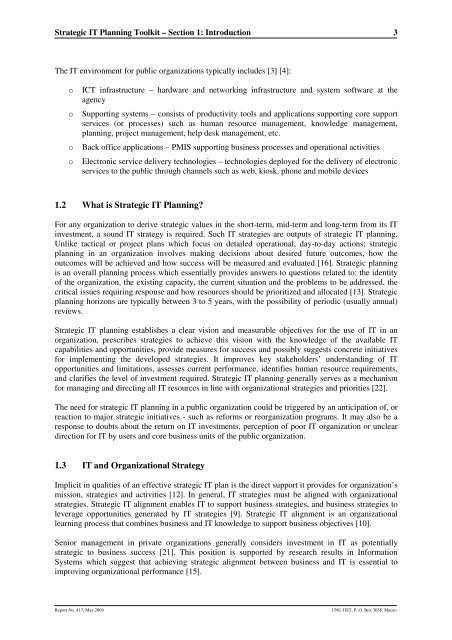Strategic IT Planning for Public Organizations: A Toolkit - UNU-IIST ...
Strategic IT Planning for Public Organizations: A Toolkit - UNU-IIST ...
Strategic IT Planning for Public Organizations: A Toolkit - UNU-IIST ...
You also want an ePaper? Increase the reach of your titles
YUMPU automatically turns print PDFs into web optimized ePapers that Google loves.
<strong>Strategic</strong> <strong>IT</strong> <strong>Planning</strong> <strong>Toolkit</strong> – Section 1: Introduction<br />
3<br />
The <strong>IT</strong> environment <strong>for</strong> public organizations typically includes [3] [4]:<br />
o ICT infrastructure – hardware and networking infrastructure and system software at the<br />
agency<br />
o Supporting systems – consists of productivity tools and applications supporting core support<br />
services (or processes) such as human resource management, knowledge management,<br />
planning, project management, help desk management, etc.<br />
o Back office applications – PMIS supporting business processes and operational activities<br />
o Electronic service delivery technologies – technologies deployed <strong>for</strong> the delivery of electronic<br />
services to the public through channels such as web, kiosk, phone and mobile devices<br />
1.2 What is <strong>Strategic</strong> <strong>IT</strong> <strong>Planning</strong>?<br />
For any organization to derive strategic values in the short-term, mid-term and long-term from its <strong>IT</strong><br />
investment, a sound <strong>IT</strong> strategy is required. Such <strong>IT</strong> strategies are outputs of strategic <strong>IT</strong> planning.<br />
Unlike tactical or project plans which focus on detailed operational, day-to-day actions; strategic<br />
planning in an organization involves making decisions about desired future outcomes, how the<br />
outcomes will be achieved and how success will be measured and evaluated [16]. <strong>Strategic</strong> planning<br />
is an overall planning process which essentially provides answers to questions related to: the identity<br />
of the organization, the existing capacity, the current situation and the problems to be addressed, the<br />
critical issues requiring response and how resources should be prioritized and allocated [13]. <strong>Strategic</strong><br />
planning horizons are typically between 3 to 5 years, with the possibility of periodic (usually annual)<br />
reviews.<br />
<strong>Strategic</strong> <strong>IT</strong> planning establishes a clear vision and measurable objectives <strong>for</strong> the use of <strong>IT</strong> in an<br />
organization, prescribes strategies to achieve this vision with the knowledge of the available <strong>IT</strong><br />
capabilities and opportunities, provide measures <strong>for</strong> success and possibly suggests concrete initiatives<br />
<strong>for</strong> implementing the developed strategies. It improves key stakeholders’ understanding of <strong>IT</strong><br />
opportunities and limitations, assesses current per<strong>for</strong>mance, identifies human resource requirements,<br />
and clarifies the level of investment required. <strong>Strategic</strong> <strong>IT</strong> planning generally serves as a mechanism<br />
<strong>for</strong> managing and directing all <strong>IT</strong> resources in line with organizational strategies and priorities [22].<br />
The need <strong>for</strong> strategic <strong>IT</strong> planning in a public organization could be triggered by an anticipation of, or<br />
reaction to major strategic initiatives - such as re<strong>for</strong>ms or reorganization programs. It may also be a<br />
response to doubts about the return on <strong>IT</strong> investments, perception of poor <strong>IT</strong> organization or unclear<br />
direction <strong>for</strong> <strong>IT</strong> by users and core business units of the public organization.<br />
1.3 <strong>IT</strong> and Organizational Strategy<br />
Implicit in qualities of an effective strategic <strong>IT</strong> plan is the direct support it provides <strong>for</strong> organization’s<br />
mission, strategies and activities [12]. In general, <strong>IT</strong> strategies must be aligned with organizational<br />
strategies. <strong>Strategic</strong> <strong>IT</strong> alignment enables <strong>IT</strong> to support business strategies, and business strategies to<br />
leverage opportunities generated by <strong>IT</strong> strategies [9]. <strong>Strategic</strong> <strong>IT</strong> alignment is an organizational<br />
learning process that combines business and <strong>IT</strong> knowledge to support business objectives [10].<br />
Senior management in private organizations generally considers investment in <strong>IT</strong> as potentially<br />
strategic to business success [21]. This position is supported by research results in In<strong>for</strong>mation<br />
Systems which suggest that achieving strategic alignment between business and <strong>IT</strong> is essential to<br />
improving organizational per<strong>for</strong>mance [15].<br />
Report No. 417, May 2009<br />
<strong>UNU</strong>-<strong>IIST</strong>, P. O. Box 3058, Macao

















